Notre Dame
Author: Stefan Feld
Publisher: Alea/Ravensburger
Year: 2007
review by

| x |
|
|
|
|
|
|
|
|
|
|
|
|
|
|
|
|
|
|
|
|
|
|
|
|
|
|
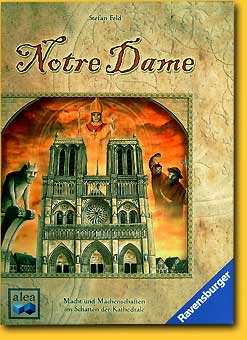 |
We are influential citizens in fourteenth century Paris. Because enough is never enough, we are attempting to even increase our wealth and fame. We all control a district where we can perform various actions in seven buildings. With these actions we can collect victory points. The player with the most victory points wins the game.
xx |
| x |
|
|
|
|
|
|
|
|
|
|
|
|
|
|
|
|
|
|
|
|
|
|
|
|
|
|
| In the middle of the board the Notre Dame tile is placed, and the districts of the 2 to 5 players are arranged around the Notre Dame. Each district is divided into eight areas: seven buildings and the docks. In the buildings actions can be performed, and in the docks we keep track of the rat infestation of our district, which is a measure for the hygiene and thus the quality of living in our district. |
| x |
|
|
|
|
|
|
|
|
|
|
|
|
|
|
|
|
|
|
|
|
|
|
|
|
|
|
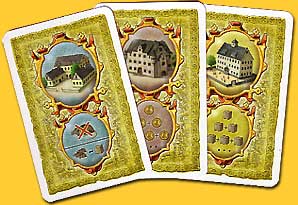 |
|
Further, there is a stock of influence cubes in the players’ colours. Each player gets four cubes for his personal supply at the beginning of the game, in addition to a deck of nine action cards in his colour. These cards indicate in what building a player can perform an action. Each round, the players take the three top cards of their deck. They each select one card, and pass the remaining two cards on to their left neighbour. Of the two cards they received from their right neighbour, one card is again passed on to the left neighbour. This way, all players end up with three action cards of different colours. |
| x |
|
|
|
|
|
|
|
|
|
|
|
|
|
|
|
|
|
|
|
|
|
|
|
|
|
|
|
The starting player chooses one of his three cards and carries out the indicated action. Then, the other players get to play one of their cards. This is repeated a second time; the third action card is discarded. The actions are coupled to the seven buildings in the seven sections of the districts. When playing a card, the first thing the player has to do is place one influence cube from his personal supply in the building depicted on the card before carrying out the action.
|
|
 |
| x |
|
|
|
|
|
|
|
|
|
|
|
|
|
|
|
|
|
|
|
|
|
|
|
|
|
|
|
When playing the Monastery, Bank or Residence cards, the player may take a number of influence cubes from the general stock, money or victory points, respectively, equal to the number of influence cubes in the building. When these cards are played several times during the game, the number of influence cubes in the buildings increases, and as a result the profits from these buildings also increase.
|
| x |
|
|
|
|
|
|
|
|
|
|
|
|
|
|
|
|
|
|
|
|
|
|
|
|
|
|
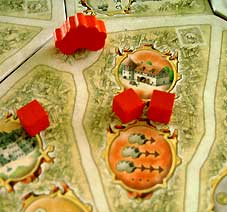 |
x |
All players also have a coach at their disposal that starts on a square at the centre of the district. When playing a Coach card, a player may move his coach as many spaces over the board as there are influence cubes in his coach station. At different locations on the board the coach can pick up tiles that score victory points, and money or influence cubes. |
x |
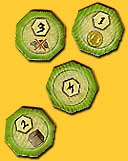 |
|
| x |
|
|
|
|
|
|
|
|
|
|
|
|
|
|
|
The Park and the Hospital exert influence on the ‘rat track’ in the docks, that indicates how many rats have infested our district. The track goes up to 9 rats, and it’s very important not to exceed this! When playing a Park card, the cube on the rat track is moved back one space. In addition, when there’s at least two influence cubes in the park, the player scores one extra victory point every time that he scores points during the remainder of the game. Playing the Hospital card also allows the player to move the counter on the rat track back one space. |
| x |
|
|
|
|
|
|
|
|
|
|
|
|
|
|
|
|
|
|
|
|
|
|
|
|
|
|
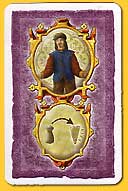 |
|
When a Guesthouse card is played, the player can choose between one coin, one cube from the general stock or moving back the rat counter. The confidant, a wooden playing figure in the player’s colour, can be considered a ‘mobile influence cube’. When the Confidant card is played, a player may place his confidant on the board in a building of his choice, or, if it already is on the board, move it to a different building. Then he may perform the action associated with the building. |
| x |
|
|
|
|
|
|
|
|
|
|
|
|
|
|
|
|
|
|
|
|
|
|
|
|
|
|
| Finally there is a Notre Dame card. When playing this card, the player places a cube in the Notre Dame in the centre of the board. He pays 1, 2 or 3 coins and immediately scores 1, 3 or 6 victory points. Later in the game, more victory points can be earned in the Notre Dame. |
|
|
| x |
|
|
|
|
|
|
|
|
|
|
|
|
|
|
|
|
|
|
|
|
|
|
|
|
|
|
| x |
|
|
|
|
|
|
|
|
|
|
|
|
|
|
|
|
|
|
|
|
|
|
|
|
|
|
 |
|
|
|
|
|
|
|
|
|
|
|
|
|
|
|
|
|
|
|
|
|
|
 |
|
|
|
|
|
|
|
|
|
|
|
|
|
|
|
|
|
|
|
|
|
|
 |
|
|
|
|
|
|
|
|
|
|
|
|
|
|
|
|
|
|
|
|
|
|
| x |
|
|
|
|
|
|
|
|
|
|
|
|
|
|
|
|
|
|
|
|
|
|
|
|
|
|
 |
|
|
|
|
|
|
|
|
|
|
|
|
|
|
|
|
 |
|
|
|
|
|
|
|
|
|
|
|
|
|
|
|
|
|